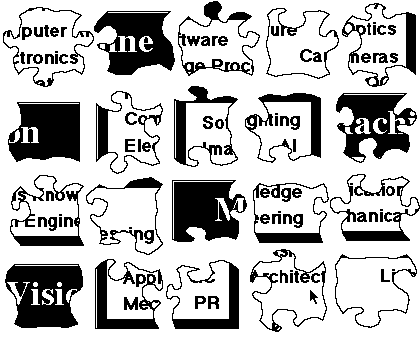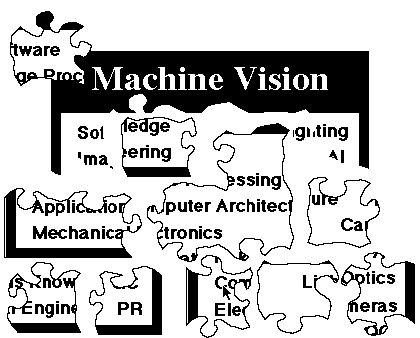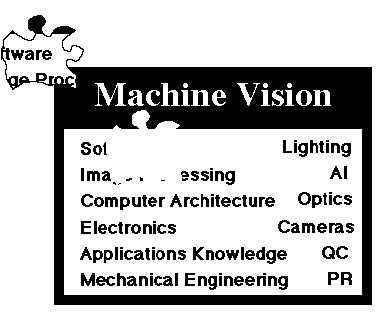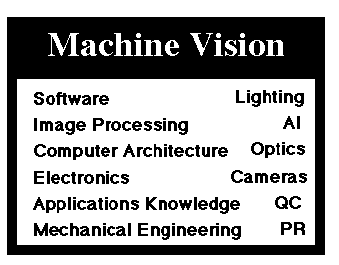
During the period 1970 - 1990, Japan taught Europe and America the importance of quality in manufactured goods. The West learned the hard way: markets were quickly lost to companies whose names were hitherto unknown. Many long established and well respected Western companies were unable to meet the challenge and consequently failed to survive. Those that did were often faced with difficult years, as their share of the market shrank. Most companies in Europe and America have largely come to terms with this and now realise that quality has a vital role in establishing and maintaining customer loyalty. In the present climate of opinion, any technology which improves or simply guarantees product quality is welcome.
Machine vision is a relatively new technology, which has much to offer manufacturing industry in improving product quality and safety, as well as enhancing process efficiency and operational safety. Machine vision owes its rising popularity to one major factor: optical sensing is inherently clean, safe (because it a non-contacting technology) and very versatile. It is possible to do certain things using vision (both human and machine) that no other known sensing method can achieve - imagine trying to sense stains, rust or surface corrosion by any other means.

Designing a machine vision system is like assembling a jigsaw.
Among other component technologies machine vision involves the digitisation, manipulation and analysis of images, usually within a computer, a subject which is also covered by the terms image processing and computer vision. However, we must emphasise that machine vision, computer vision and image processing are not synonymous. None is a subset of either of the others. Computer vision is a branch of Computer Science, while machine vision is an area of specialisation within Systems Engineering. Notice, in particular, the use of the words "Science" and "Engineering" here. Machine vision does not necessarily imply the use of a computer; specialised image processing hardware is often used to obtain higher processing speeds than a conventional computer can achieve.
Machine vision system for industry first received serious attention in the mid-1970s, although the proposal that a video system be used for industrial inspection was first made in the 1930s. Throughout the early 1980s, the subject developed slowly, with a steady contribution being made by the academic research community, but with only limited industrial interest being shown. It seemed in the mid-1980s that there would be a major boost to progress, with serious interest being shown in vision systems by the major American automobile manufacturers. Then, came a period of serious disillusionment in the USA, with a large number of small vision companies failing to survive. In the late 1980s and early 1990s, interest has grown markedly, due largely to significant progress being made in making fast, dedicated image digitisation and processing hardware. In the mid-1990s, the role of the general purpose processor is being revised, with the modern RISC processors offering high processing speed on a standard computing platform. Throughout this period, academic workers have been steadily proving feasibility in a very wide range of products, representing all of the major branches of manufacturing industry.

Soon after starting work, machine vision is seen as a confusing jumble of disconnected ideas.
Industrial image processing systems, which necessarily form part of a vision system, have developed very considerably in the last decade. In addition, there have been major advances in other component technologies: image sensors, specialised lighting units, lenses and advisor (CAD) programs, which guide a vision engineer through the initial stages of the design process. However, systems integration remains the key factor for the successful design and operation of a machine vision system.
There are numerous techniques for manipulating images that are either not used, at all, or are used very infrequently in machine vision. Wherever there are problems of computational speed, machine vision systems engineers will either seek another solution, or avoid the problem entirely. Standard image processing techniques are able to achieve some remarkable results but they could not be described as being intelligent. By adding a certain level of intelligence, we are able to do certain things that would otherwise be impossible. For example, analysing the image of a standard ("analogue") clock, in order to tell the time is one such task that could not be solved using "traditional" image processing methods working on their own.

There is a serious bottleneck in the design of machine vision systems: a high level of Eventually, the pieces fit together. However, if one piece is missing, the result is imperfect; system integration is incomplete. skilled man-power is needed to achieve an effective design. To illustrate the problem, consider the case of just one organisation, which has over 60000 products. That company operates a policy which tries to maintain at least 25% of its sales on products that are not more than 5 years old. Simple arithmetic shows that over 10 new product are being introduced by that one company alone, every working day. If we were to use a machine vision system on only 1% of those new product lines, we would need to design, build, install and test a new system once every 2 weeks. At the moment, the design process typically takes several months and there are simply not enough machine vision engineers to provide that kind of level of support, even for that one company. We desperately need more well-educated machine vision systems engineers. We also need improved design tools. By claiming that machine vision is a flexible technology, without having the man-power available to fulfil that boast is simply foolish. Such "overselling" of the virtues of machine vision technology was largely responsible for the collapse in credibility and confidence in the mid-1980s, to which we referred earlier. We need both improved educational material and better engineering tools, if we are to meet the challenge that this subject imposes upon us. Working in such a flexible and potentially beneficial technology carries responsibilities, because it is upon our shoulders that its future development and exploitation lies.

System integration is complete; all elements are now in place. The result is perfect (machine) vision.